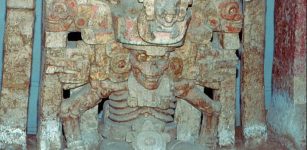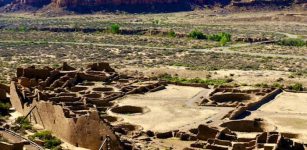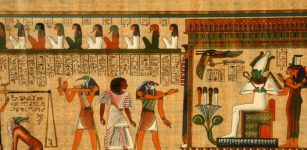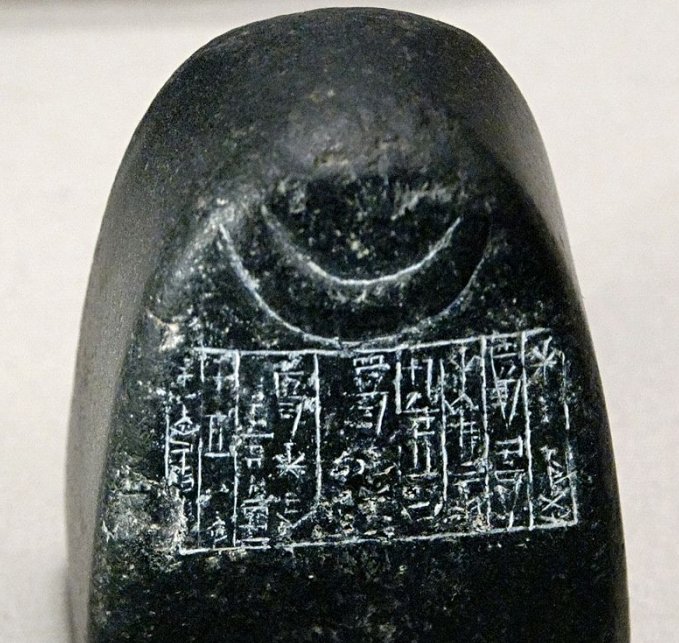Divine Shulgi Of Ur: Influential, Long-Ruling King, Conqueror And Native Akkadian Speaker In Five Languages
A. Sutherland - AncientPages.com - Shulgi (2095-2048 BC) was the son of Ur-Nammu and his successor. With Ur-Nammu started the famed Third Dynasty of Ur and the prosperous so-called Ur III Period.
During his long (48-year) reign, Shulgi strengthened and expanded the state created by his father. He reorganized the already existing system and strengthened its international prestige, making it real power.
Foundation figure of king Shulgi of Ur, carrying a basket. Metalwork-Sculpture. Image credit: Metropolitan Museum of Art - CC0
Not only epics and myths but also hymns played a very important role in Sumerian literature. They honored prominent figures and one of them was Shulgi, the second ruler of the Third Dynasty of Ur (circa 2094-2047 BC).
He boasted about his successes and he did it with good reason.
Shulgi was a son of Ur-Nammu, a founder of the Third Dynasty of Ur, and a Sumerian king who reigned about 2112-2095 BC. Like his father, Ur-Nammu, he was a great politician, and also an excellent commander. Shulgi’s 48-year-long reign contributed to important achievements.
Achievements Of Shulgi Were Significant
At the end of 3000 BC, new leaders from Ur, the 3rd dynasty took power in the region. One was Ur-Nammu, the other was his son Shulgi.
Like his father, Shulgi can be credited with the building of ziggurats and great temples in cities of Mesopotamia.
He introduced standard weights and measurements and encouraged trade on safe roads where people could move between cities, without fear of being attacked and robbed. Every tax that was paid was registered on clay tablets by scribes; many of these tablets were found well-preserved. The country’s territory increased significantly, giving it international prestige.
In the beginning, the kingdom, Shulgi inherited was not large and included only central and southern Mesopotamia. The small kingdom has usually difficulties defending itself against the large ones. Therefore, Shulgi began his reign with a policy of conquest (focusing on Elam and the mountains of Zagros) and achieved a number of successes. He appointed a large army.
Shulgi Boasted Much About His Abilities And With Good Reason
As the most influential ruler of Ur III king, Shulgi was a native Akkadian speaker who was fluent in five languages like Elamite, Sumerian, Hurrian, Amorite, and even Meluhhan (Dravidian). He was trained as a scribe and organized schools for scribes. He was a self-confident ruler who declared himself a divinity and established a tradition of royal praise for himself in many hymns.
A half-mina weight (248 g.), bearing the name of king Shulgi. Image credit: Rama - CC BY-SA 2.0 FR
“Shulgi boasts that he hunts lions and serpents in steppe…. without the aid of a net or enclosure… He claims to be so fast on his feet he can catch a gazelle on the run..” (Kramer N. S.)
Usually, people wrote hymns for the gods, but Shulgi wrote a hymn to honor himself.
In “The Sumerian World,” Harriet Crawford writes that “by some accounts, in 2088 BC, during what is known as the King’s Run, documents show that Shulgi claimed that during a celebration of eshesh, he ran the distance of the parade (200 miles round-trip) from Nippur to Ur and back.
“That my name be established until distant days and that it leaves not the mouth of men, that my praise be spread wide in the land; I, the runner rose in my strength… and from Nippur to Ur I resolved to travel…”
"My black-headed people marveled at me" he wrote.
The problem is that Nippur was at a distance of 100 miles from Ur. Shulgi claimed that he runs 100 miles and then he runs back home again. All that happened in one day and during a storm. Did Shulgi really run 200 miles in the stormy weather or was it only a way to glorify himself?
This tablet glorifies King Shulgi and his victories on the Lullubi people and it mentions the modern city of Erbil and the modern district of Sulaymaniyah. 2111-2004 BCE. The Sulaymaniyah Museum, Iraq. Image credit: Osama Shukir Muhammed Amin FRCP(Glasg) - CC BY-SA 4.0
We don't know, however, Kramer refers to Shulgi as "the first long-distance running champion."
We can only say that even if his marathon race was only boasting, Shulgi had many other impressive achievements that were praised.
Shulgi Involved In Many Military Campaigns
He was at war on a regular basis; he clashed with Hurrian invaders, built reinforcements to keep the Amorites out. At the same time, he was actively involved in the interior affairs of his country.
He arranged several royal expeditions in three large campaigns and penetrated several hostile regions, eventually covering the entire area of western Zagros. He used both, the military supremacy of Ur and diplomatic means, depending on the circumstances. However, he preferred diplomatic actions, if possible.
After 48 years of rule, Shulgi left the kingdom three times wider, strong, with bounded borders and with a well-functioning centralized administrative system.
Shulgi And His Laws
It is said that Shulgi was concerned about the poor and weak people in his great kingdom. One of his inscriptions says “I did not deliver the orphan to the rich. I did not deliver the widow to the mighty. I got rid of hatred and violence and established justice in the land.”
He put together laws on clay tablets, but unfortunately only the first 37 of these earliest written laws - survived. He named different crimes and punishments for them. By his laws, he discouraged people from taking justice in their own hands. Later, Hammurabi appeared with his famous code. Hammurabi's' laws survive because they were recorded on stone, Shulgi's on the other hand, used only clay tablets.
Written by – A. Sutherland - AncientPages.com Senior Staff Writer
Copyright © AncientPages.com All rights reserved. This material may not be published, broadcast, rewritten or redistributed in whole or part without the express written permission of AncientPages.com
Expand for referencesReferences:
Kramer N. S. In the World of Sumer
Freeman, H. Sumerians
Kramer, Samuel Noah. "Shulgi of Ur: A Royal Hymn and a Divine Blessing." The Jewish Quarterly Review 57 (1967): 369-80.
Barjamovic G. Ryholt K. Problems of Canonicity and Identity Formation in Ancient Egypt and Mesopotamia
More From Ancient Pages
-
 On This Day In History: Naval Battle Of Rennell Island Fought Off Guadalcanal – On Jan 29, 1943
News | Jan 29, 2017
On This Day In History: Naval Battle Of Rennell Island Fought Off Guadalcanal – On Jan 29, 1943
News | Jan 29, 2017 -
 Incredible 500,000-Year-Old ‘Paradise’ With Thousands of Artifacts Discovered In Israel
Archaeology | Jan 24, 2018
Incredible 500,000-Year-Old ‘Paradise’ With Thousands of Artifacts Discovered In Israel
Archaeology | Jan 24, 2018 -
 Mictlan – Underworld Realm Of The Dead In Ancient Aztec Beliefs
Aztec Mythology | Jul 2, 2018
Mictlan – Underworld Realm Of The Dead In Ancient Aztec Beliefs
Aztec Mythology | Jul 2, 2018 -
 Ancient Maya Destroyed Their Environment 2,000 Years Ago – Effects Are Still Visible Today
Civilizations | Sep 9, 2015
Ancient Maya Destroyed Their Environment 2,000 Years Ago – Effects Are Still Visible Today
Civilizations | Sep 9, 2015 -
 Slaves In The Aztec Empire Had Much Better Rights Than In Any Other Ancient Society
Ancient History Facts | Jul 6, 2016
Slaves In The Aztec Empire Had Much Better Rights Than In Any Other Ancient Society
Ancient History Facts | Jul 6, 2016 -
 Ancient Chaco Canyon Was Much More Than A Ceremonial Site New Study Reveals
Archaeology | Oct 28, 2021
Ancient Chaco Canyon Was Much More Than A Ceremonial Site New Study Reveals
Archaeology | Oct 28, 2021 -
 Hogmanay: Scotland’s New Year Celebration Inherited From The Vikings
Ancient Traditions And Customs | Dec 31, 2024
Hogmanay: Scotland’s New Year Celebration Inherited From The Vikings
Ancient Traditions And Customs | Dec 31, 2024 -
 Controversial Statue Of Anglo-Norman Knight William Marshal In Pembroke Faces Criticism
Artifacts | May 10, 2022
Controversial Statue Of Anglo-Norman Knight William Marshal In Pembroke Faces Criticism
Artifacts | May 10, 2022 -
 Day Of The Dead: From Aztec Goddess Worship To Modern Mexican Celebration
Ancient Traditions And Customs | Oct 30, 2019
Day Of The Dead: From Aztec Goddess Worship To Modern Mexican Celebration
Ancient Traditions And Customs | Oct 30, 2019 -
 19th Century Mass Grave With Hundreds Decapitated “Vampires” Discovered In Polish Village
Archaeology | Jun 23, 2023
19th Century Mass Grave With Hundreds Decapitated “Vampires” Discovered In Polish Village
Archaeology | Jun 23, 2023 -
 First Book Of Breathing: Egyptian Papyrus Sheds Light On Funerary Text Helping The Deceased In Afterlife
News | Oct 22, 2020
First Book Of Breathing: Egyptian Papyrus Sheds Light On Funerary Text Helping The Deceased In Afterlife
News | Oct 22, 2020 -
 Gravitational Waves Shed Light On The Mysterious Antikythera Mechanism
News | Jun 29, 2024
Gravitational Waves Shed Light On The Mysterious Antikythera Mechanism
News | Jun 29, 2024 -
 Rare Minoan Sealstone Is A Miniature Masterpiece Unearthed In 3,500-Year-Old Tomb Of Powerful Mycenaean Warrior
Archaeology | Nov 8, 2017
Rare Minoan Sealstone Is A Miniature Masterpiece Unearthed In 3,500-Year-Old Tomb Of Powerful Mycenaean Warrior
Archaeology | Nov 8, 2017 -
 Shining Ones And Magic In Ireland – Secret Wisdom Of The Gods
Celtic Mythology | May 9, 2014
Shining Ones And Magic In Ireland – Secret Wisdom Of The Gods
Celtic Mythology | May 9, 2014 -
 Largest Viking-Age Building In Britain Has Been Found In Cumbria!
Archaeology | Feb 18, 2025
Largest Viking-Age Building In Britain Has Been Found In Cumbria!
Archaeology | Feb 18, 2025 -
 ‘Sensational’ Discovery Of Large Untouched 4,000-Year-Old Grave In Norway
Archaeology | Nov 10, 2023
‘Sensational’ Discovery Of Large Untouched 4,000-Year-Old Grave In Norway
Archaeology | Nov 10, 2023 -
 Cynane: Talented Female Military Leader Assassinated While Giving A Speech
Featured Stories | Mar 5, 2019
Cynane: Talented Female Military Leader Assassinated While Giving A Speech
Featured Stories | Mar 5, 2019 -
 Ancient Fossils Reveal Climate Altered Humans’ Body And Brain Size
Archaeology | Jul 8, 2021
Ancient Fossils Reveal Climate Altered Humans’ Body And Brain Size
Archaeology | Jul 8, 2021 -
 Why Did Ancient Egyptian Scribes Face Serious Health Risks?
Archaeology | Jun 27, 2024
Why Did Ancient Egyptian Scribes Face Serious Health Risks?
Archaeology | Jun 27, 2024 -
 10 Viking, Norse And Icelandic Symbols Explained
Vikings | Sep 5, 2023
10 Viking, Norse And Icelandic Symbols Explained
Vikings | Sep 5, 2023



